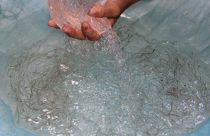ANGUILLID EEL BASELINE SURVEY IN PHILIPINES
Under the support from SEAFDEC/JAIF Project, a field trip was conducted to collect data statistics on eel fisheries and also to collect samples of tissues of Anguilla bicolor pacifica for DNA analysis. Regarding to the objectives of the project on DNA analysis, it is to determine the connectivity of the population Anguilla bicolor in Southeast Asia. The survey was conducted on July 16-23, 2018, by SEAFDEC/SEC (Ms. Parinthon Veerapattananon), SEAFDEC/IFRDMD (Ms. Melfa Marini), SEAFDEC/AQD (Dr. Maria Lourdes C. Aralar, Dr. Frolan Aya, Mr. Dan Lagronio), BFAR-Region2 (Dr. Evelyn Ame), NFRDI (Dr. Mudjiekeewis Santos), and BFAR-ARMM (Dr. Macmod Mamalangkap). During the survey, the team visited nine eel farms in Luzon and Mindanao. In the first day, we visited Abalos Aqua Farm in Mabanglit, Cabangan, Zambales Province with the capital of Fernando Pampanga of Luzon island. This farm rears two species, Anguilla bicolor and Anguilla marmorata which captured from General Santos Province. The EDL farm is the traditional eel farm and raises only Anguilla marmorata on the stage of elvers and yellow eels. Afterward, we visited Good Eel Fishery Corporation, located in Boso-boso, which established in 2013 and rear about 99% Anguilla marmorata. Besides, we also visited Eels Press Trading which grows part of Anguilla bicolor and part else of Anguilla marmorata from Gensen. In the second day, a visitation was done to Binangonan Freshwater Station and Eel fish farm.
 The Shizo-tech Trading, General Santos, Mindanao, established in 2010, grows 75% Anguilla bicolor and 25% Anguilla marmorata, that the seeds caught from Ladol River. We have a chance to visit the MOU Farm. This farm has not registered yet since it was established last six months. We also visited the largest farm namely, General Santos, the leading supplier in Manila, existed since 2010, and now this farm becomes the center of eel selling activity. From this survey, we determine that there are three main areas of eel production, Ladol (80% Anguilla bicolor and 20% Anguilla marmorata), Colobau (20% Anguilla bicolor and 60% Anguilla marmorata) and Saranggani (50% for Anguilla bicolor and Anguilla marmorata respectively). We consider collecting 50 eel samples from Luzon and Mindanao, respectively. From the survey, we got the sample from Ladol River, Mindanao. Continuing this survey, Dr. Mudjiekeewis and Dr. Ame will collect the sample from Luzon inland (MM).
The Shizo-tech Trading, General Santos, Mindanao, established in 2010, grows 75% Anguilla bicolor and 25% Anguilla marmorata, that the seeds caught from Ladol River. We have a chance to visit the MOU Farm. This farm has not registered yet since it was established last six months. We also visited the largest farm namely, General Santos, the leading supplier in Manila, existed since 2010, and now this farm becomes the center of eel selling activity. From this survey, we determine that there are three main areas of eel production, Ladol (80% Anguilla bicolor and 20% Anguilla marmorata), Colobau (20% Anguilla bicolor and 60% Anguilla marmorata) and Saranggani (50% for Anguilla bicolor and Anguilla marmorata respectively). We consider collecting 50 eel samples from Luzon and Mindanao, respectively. From the survey, we got the sample from Ladol River, Mindanao. Continuing this survey, Dr. Mudjiekeewis and Dr. Ame will collect the sample from Luzon inland (MM).
